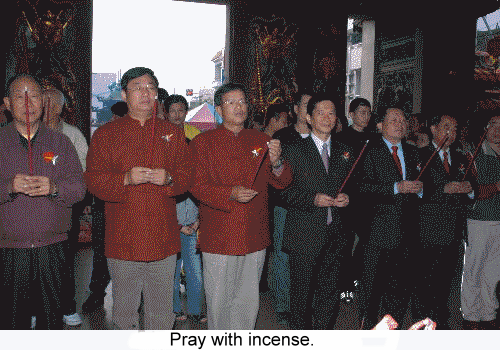| Pasting the Dragons | Dotting the Dragons’ Eyes | Welcoming the Dragons | Following the Dragons | Bombing the Dragons | Sending the Dragons Back to Heaven |
![]() Dotting
the Dragons’ Eyes
Dotting
the Dragons’ Eyes
According to the early Hakka customs in Miaoli, dragons cannot visit the public until their eyes are dotted at local Earth God temples on the afternoon of January 15th. Sometimes, in order to keep evil influences away from the dragon and show respect for the gods, the eye-dotting ceremony is conducted right after the dragon is pasted. And the dragon should be worshipped every morning and evening until January 15th.
To promote the conservation and education of this unique culture, the Miaoli City Office has gathered all the dragon dance teams in Miaoli to attend the eye-dotting ceremony on January 9th of the lunar calendar at Yucin Temple in Miaoli City.
The purpose of the eye-dotting ceremony is to pray to the gods to bestow divinity upon the dragon, which will protect people by making a tour of the town. In the ceremony, animal sacrifices are offered to the gods along with prayers. Then, cinnabar mixed with the blood of a white rooster’s cockscomb and rice wine is applied with a new ink brush to the dragon’s head, body and tail. After that, a red cloth with golden flowers is hung from the dragon’s horns. During the ceremony, the dragon team members hold the handles on the dragon body with their right hands and kneel on their right knees to welcome the deity. After the eyes are dotted, the dragon becomes the “dragon god.” All the team members rise to dance the dragon dance to thank the gods, accompanied by the sound of gongs and drums. After the ceremony is completed, the dragon can start visiting the public.
Dragon eyes are dotted with the mixture of the cockscomb blood of a white rooster, cinnabar and rice wine, each of which has different symbolic meanings: white roosters symbolize “nobility, power and reverence”; white symbolizes “purity,” cockscombs symbolize “supremacy,” and the blood of cockscombs symbolizes “the supreme life.” In traditional customs, cinnabar is holy and can eliminate evil influence; rice wine can help birth and the movement of chi (energy); and the red cloth with golden flowers represents joy and good fortune. The dragon is given life after the ceremony and becomes the “dragon god.” According to Hakka customs, dragons whose eyes are not dotted are “wild dragons.” They can only perform in festivals but cannot enter temples; nor can they be welcomed, received or offered red envelopes by the public.
In addition to the meaningful material, people who dot dragon eyes also need to speak the symbolic meaning of each part of the dragon as they go through the process.
| 1.9 sections |
(1) Hold the brush and face the dragon head – dot the dragon and gather blessings (2) Dot the eyes: dot the left eye – bring light to the eyes; dot the right eye – view the distance (3) Dot the ears: dot the left ear – hear the wind; dot the right ear – hear the distance (4) Dot the nose – smell everything (5) Dot the mouth – drink sweet dew from the universe (6) Dot the forehead – 1. heaven and earth (7) Dot the body: 2. sun and moon 3. stars 4. wind and rain 5. thunder and lightning 6. water and fire 7. mountains and rivers 8. sweet dew 9. all things are fortunate (dragon tail) |
|
2. 11 sections
|
(1) to (6), same as above (7) Dot the body: 2. sun and moon 3. stars 4. wind and rain 5. thunder and lightning 6. gold and wood 7. water and fire 8. hills and streams 9. sweet dew 10. mountains and rivers 11. peaceful world (dragon tail) |
|
3. 15 sections
|
(1) to (5), same as above (6) Dot the forehead: 1. heaven (7) Dot the body: 2. earth 3. sun 4. moon 5. stars 6. wind 7. rain 8. thunder 9. lightning 10. water 11. fire 12.mountains 13. rivers 14. ocean 15. happy and wealthy nation (dragon tail) |
![]() The
eye-dotting procedure
The
eye-dotting procedure

![]() Data
source
Data
source
Many thanks to the Miaoli City Office for provision of photos and relevant text.
Contents also referred to the 2003-2008 Miaoli International Cultural Tourism Festival Proposal.
Data compilation: Shih-Min Lin, Wan-Ling Chen